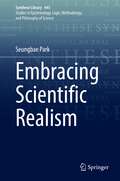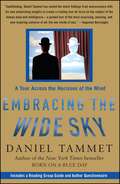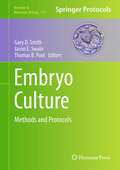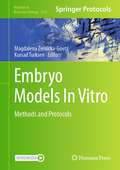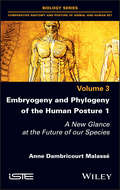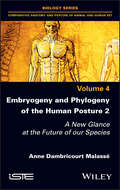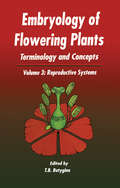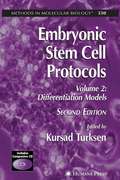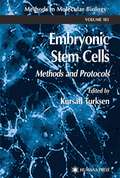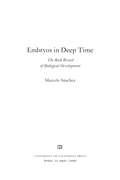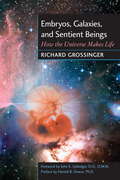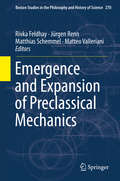- Table View
- List View
Embracing Mind: The Common Ground of Science and Spirituality
by B. Alan Wallace Brian HodelWhat is Mind? For this ancient question we are still seeking answers. B. Alan Wallace and Brian Hodel propose a science of the mind based on the contemplative wisdom of Buddhism, Hinduism, Taoism, Christianity, and Islam.The authors begin by exploring the history of science, showing how science tends to ignore the mind, even while it is understood to be the very instrument through which we comprehend the world of nature. They then propose a contemplative science of mind based on the sophisticated techniques of meditation that have been practiced for thousands of years in the great spiritual traditions. The final section presents meditations that are of universal relevance--to scientists and people of all faiths--for revealing new dimensions of consciousness and human flourishing. Embracing Mind moves us beyond the dogmatic debates between theists and atheists over Intelligent Design and Neo-Darwinism, and it returns us to the vital core of science and spirituality: deepening our experience of reality as a whole.
Embracing Scientific Realism (Synthese Library #445)
by Seungbae ParkThis book provides philosophers of science with new theoretical resources for making their own contributions to the scientific realism debate. Readers will encounter old and new arguments for and against scientific realism. They will also be given useful tips for how to provide influential formulations of scientific realism and antirealism. Finally, they will see how scientific realism relates to scientific progress, scientific understanding, mathematical realism, and scientific practice.
Embracing the Fog of War: Assessment and Metrics in Counterinsurgency
by Ben ConnableThe unpredictable counterinsurgency environment challenges centralized, quantitative campaign assessment. A comprehensive examination of the centralized, quantitative approach to assessment, as described inthe literature and doctrine and applied in two primary case studies (Vietnam and Afghanistan), reveals weaknesses and gaps and proposes an alternative process: contextual assessment.
Embracing the Future, Powering Growth: An Energy System Renewed for China (Advances in Oil and Gas Exploration & Production)
by Shell International B.V. Development Research Centre of the State Council (DRC) of People’s Republic of ChinaTo build a new energy system is the key towards China's goal of carbon emissions peak and achieving carbon neutrality. The new energy system will reshape the conventional energy system in an integrated and revolutionary way. It will not only bring about major changes in energy production, utilization and consumption, as well as emissions of greenhouse gas (GHG) and local pollutants, but also have profound implications on technological innovation and economic development. Based on quantitative and systematic analysis, this study depicts the energy system by 2030 and by 2060, analyzes the impacts of the energy system on economic and social development, studies and judges the key risk points, and proposes the path and policy system for building a new energy system.This is an open access book.
Embracing the Wide Sky: A Tour Across the Horizons of the Mind
by Daniel TammetOwner of "the most remarkable mind on the planet," (according to Entertainment Weekly) Daniel Tammet captivated readers and won worldwide critical acclaim with the 2007 New York Times bestselling memoir, Born On A Blue Day, and its vivid depiction of a life with autistic savant syndrome. In his fascinating new book, he writes with characteristic clarity and personal awareness as he sheds light on the mysteries of savants' incredible mental abilities, and our own.
Embryo Culture
by Gary D. Smith Thomas B. Pool Jason E. SwainAssisted reproductive technologies have had a profound impact on biomedical research through transgenic animals, food supply and production, as wells as genetic gain of domestic species, and treatment of human infertility. While significant advances in embryo culture have occurred over the last few decades. In Embryo Culture: Methods and Protocols, expert researchers in the field detail many of the methods which are now commonly used to study human embryo culture. These include emerging methods and the impact of embryo culture on epigenetics and offspring health is presented to set the stage for future research and laboratory application involving embryo culture. Written in the highly successful Methods in Molecular BiologyTM series format, chapters include introductions to their respective topics, lists of the necessary materials and reagents, step-by-step, readily reproducible laboratory protocols, and key tips on troubleshooting and avoiding known pitfalls. Authoritative and practical, Embryo Culture: Methods and Protocols seeks to aid scientists in the further study of this crucially important field of embryology and assisted reproductive technologies.
Embryo Models In Vitro: Methods and Protocols (Methods in Molecular Biology #2767)
by Kursad Turksen Magdalena Zernicka-GoetzThis collection explores the use of pluripotent cells to generate early embryo-like structures in vitro, with the resultant 3D embryo-like structures in vitro phenocopying many of the developmental landmarks and 3D architectures seen normally in vivo. The protocols gathered herein cover diverse aspects of the topic and exemplify some of the key developments and improvements in the field. Written for the highly successful Methods in Molecular Biology series, chapters include introductions to their respective topics, lists of the necessary materials and reagents, step-by-step and readily reproducible laboratory protocols, and tips on troubleshooting and avoiding known pitfalls. Authoritative and practical, Embryo Models In Vitro: Methods and Protocols serves as an ideal guide to these exciting and innovative advances in developmental biology.
Embryogenesis
by Richard Grossinger Phoebe Gloeckner Jillian O'MalleyEmbryogenesis is an unusual book in that it brings together a highly illustrated, practical embryology book in simple language, perfect for health practitioners, with a fascinating read on the history and philosophy of biological science. It discusses the various stages of embryonic development (meiosis, fertilization, blastula development, and gastrulation, and then the embryology of each of the human organs and organ systems in detail). It puts each of them in context, both in terms of its phylogeny: the evolutionary trajectory of cell-organized systems on Earth, and its ontogeny: the formation of individual organisms in the modern world. There are 24 color plates, many of them commissioned uniquely for this volume, and several hundred black and white illustrations. The book is 950 pages hardcover, 8-1/2 by 10.Chapters include: The Original Earth; The Materials of Life; The First Beings; The Cell; The Genetic Code; Sperm and Egg; Fertilization; The Blastula; Gastrulation; Morphogenesis; Biological Fields; Chaos, Fractals, and Deep Structure; Ontogeny and Phylogeny; and Biotechnology. The Origin of the Nervous System; The Evolution of Intelligence; Neurulation and the Human Brain; Organogenesis; The Musculoskeletal and Hematopoietic Systems; Mind; The Origin of Sexuality and Gender. Healing; Transsexuality, Intersexuality, and the Cultural Basis of Gender; Self and Desire; Cosmogenesis and Mortality
Embryogeny and Phylogeny of the Human Posture 1: A New Glance at the Future of our Species
by Anne Dambricourt MalasseThe future of the human posture is in the spotlight. The 200-year-old locomotion paradigm can no longer resist the advancement of knowledge, yet 2,500 years of thinking on the place of verticalized human anatomy and its reflexive consciousness in the natural history of life and the Earth, is more relevant than ever.This book retraces these reflections from pre-Socratic philosophers, focusing on the link between verticality and the most complex and consciously reflexive nervous system on the top rung of the ladder of living beings. The origin of animated forms, or animals, was considered metaphysical until the 19th century but reflection on their inception, from fertilization, paved the way for mathematics of infinitesimal geometry and dynamics. The simian filiation was inconceivable until Jean-Baptiste de Lamarck bridged the gap in 1802 with the locomotion postulate to explain the transition from quadrupedal to bipedal posture, sustained by the hypothesis of inheritance of acquired characteristics. This doctrine was overturned in 1987 by the discovery of the embryonic origins of the straightening - specific dynamics linked to neurogenesis - confirming the natural place of human verticality and nervous system complexity with its psychomotor and cognitive consequences.Sapiens find themselves at the physical limit of the straightening while mechanisms of gametogenesis have never ceased in making neurogenesis exponentially more complex. Is the future exclusively terrestrial or does intrauterine hominization open up new perspectives for space exploration? Posturologists, occlusodontics, osteopaths, cognisciences - all anthropological sciences exposed to human verticality are concerned with this discovery, which allows Sapiens to face their natural destiny
Embryogeny and Phylogeny of the Human Posture 2: A New Glance at the Future of our Species
by Anne Dambricourt MalasseThe future of the human posture is in the spotlight. The 200-year-old locomotion paradigm can no longer resist the advancement of knowledge, yet 2,500 years of thinking on the place of verticalized human anatomy and its reflexive consciousness in the natural history of life and the Earth, is more relevant than ever.This book retraces these reflections from pre-Socratic philosophers, focusing on the link between verticality and the most complex and consciously reflexive nervous system on the top rung of the ladder of living beings. The origin of animated forms, or animals, was considered metaphysical until the 19th century but reflection on their inception, from fertilization, paved the way for mathematics of infinitesimal geometry and dynamics. The simian filiation was inconceivable until Jean-Baptiste de Lamarck bridged the gap in 1802 with the locomotion postulate to explain the transition from quadrupedal to bipedal posture, sustained by the hypothesis of inheritance of acquired characteristics.This doctrine was overturned in 1987 by the discovery of the embryonic origins of the straightening – specific dynamics linked to neurogenesis – confirming the natural place of human verticality and nervous system complexity with its psychomotor and cognitive consequences. Sapiens find themselves at the physical limit of the straightening while mechanisms of gametogenesis have never ceased in making neurogenesis exponentially more complex. Is the future exclusively terrestrial or does intrauterine hominization open up new perspectives for space exploration? Posturologists, occlusodontics, osteopaths, cognisciences – all anthropological sciences exposed to human verticality are concerned with this discovery, which allows Sapiens to face their natural destiny.
Embryology and the Rise of the Gothic Novel (Palgrave Studies in Literature, Science and Medicine)
by Diana Pérez EdelmanThis book argues that embryology and the reproductive sciences played a key role in the rise of the Gothic novel in the eighteenth and nineteenth centuries. Diana Pérez Edelman dissects Horace Walpole’s use of embryological concepts in the development of his Gothic imagination and provides an overview of the conflict between preformation and epigenesis in the scientific community. The book then explores the ways in which Gothic literature can be read as epigenetic in its focus on internally sourced modes of identity, monstrosity, and endless narration. The chapters analyze Horace Walpole’s The Castle of Otranto; Ann Radcliffe’s A Sicilian Romance, The Italian, and The Mysteries of Udolpho; Mary Shelley’s Frankenstein; Charles Robert Maturin’s Melmoth the Wanderer; and James Hogg’s Confessions of a Justified Sinner, arguing that these touchstones of the Gothic register why the Gothic emerged at that time and why it continues today: the mysteries of reproduction remain unsolved.
Embryology of Flowering Plants: Reproductive Systems (Embryology Of Flowering Plants Ser.)
by T. B. BatyginaPlant embryology, dealing with the regularities of initiation and the first stages of development of an organism, is now flourishing because of the overall progress being made in natural sciences. Such discoveries of the 20th century as production of plants from a single somatic cell, experimental haploidy, and parasexual hybridization were of general biological significance. The combined efforts of embryologists, geneticists and molecular biologists yielded the discovery of specific genes that control meiosis, egg cell development and early stages of embryogenesis. The tendency to synthesize data of embryology and genetics has become increasingly noticeable. It is connected with the fact that the majority of problems connected with morphogenesis, such as differentiation, specialization, the evaluation of features and the definition of the notionsgene and feature andgenotype and phenotype concern embryology and genetics (embryogenetics) in one way or another. Evolutionary embryology has given rise to a new approach to the study of problems of adaptation in plants. In connection with the problem of preserving biological diversity under conditions of ecological stress, special attention is paid to ecological embryology, revealing the critical periods in early ontogenesis and plasticity and tolerance of reproductive systems at the level of species and population. The study of variability of morphogenesis and phenotype in population (life cycle variations and the diversity of reproductive systems) is the most important point in the population embryology of plants.
Embryonic Stem Cell Immunobiology
by Nicholas ZavazavaBone marrow stem cells are the most transplanted cells worldwide. These cells are used as a replacement therapy for patients suffering from a diverse number of hematopoietic diseases and immunodeficiencies. However, the use of bone marrow cells in regenerative medicine has so far remained without much success. In the new era of pluripotent stem cells, great opportunities for establishing new therapies have opened up. The discovery of human embryonic stem cells and that of induced pluripotent (iPS) stem cells has made it possible to derive any desired tissues for regenerative medicine as iPS cell derived cells are only limited by the lack of established protocols that can be applied in humans. There is no doubt that stem cells present a new and innovative platform for establishing novel cell based therapies. The challenge is to establish new protocols that allow the successful differentiation of these cells into lineage committed cells. Embryonic Stem Cell Immunobiology: Methods and Protocols covers a variety of relevant topics, such as hematopoietic stem cells derived from ES cells, the interaction of these cells with natural killer cells or with cytotoxic T cells, and specific protocols for the derivation of hematopoietic cells and neuronal cells, to name a few. Written in the highly successful Methods in Molecular Biology series format, chapters contain introductions to their respective topics, lists of the necessary materials and reagents, step-by-step, readily reproducible laboratory protocols, and notes on troubleshooting and avoiding known pitfalls. Authoritative and accessible, Embryonic Stem Cell Immunobiology: Methods and Protocols serves as an ideal guide to experts and non-experts interested in different aspects of stem cells.
Embryonic Stem Cell Protocols, 3rd Edition
by Kursad TurksenThis extensive volume explores areas of intense activity related to the very early commitment of stem cells to particular lineages and the progression of differentiation to mature cell stages. Research on embryonic stem cells continues to move very quickly, thus the kinds of studies continue to expand and diversify, and methodologies are continuously being refined and improved, which this book reflects. Written in the highly successful Methods in Molecular Biology series format, chapters include introductions on their respective topics, lists of the necessary materials and reagents, step-by-step, readily reproducible laboratory protocols, and tips on troubleshooting and avoiding known pitfalls.<P><P> Comprehensive and fully updated, Embryonic Stem Cell Protocols, Third Edition serves as an ideal reference for researchers investigating this rich area of study.
Embryonic Stem Cell Protocols, Volume II: Differentiation Models, 2nd Edition
by Kursad TurksenDrawing on the dramatically increasing research on embryonic stem (ES) cell biology and differentiation, Kursad Turksen has completely updated and expanded his highly acclaimed first edition of Embryonic Stem Cells: Methods and Protocols into two volumes. The second volume, Embryonic Stem Cell Protocols: Differentiation Models, Second Edition, covers state-of-the-art methods for deriving many types of differentiating cells from ES cells. A companion first volume, Embryonic Stem Cell Protocols: Isolation and Characterization, Second Edition, focuses on ES cells recently isolated from different nonhuman species, to provide a diverse collection of readily reproducible cellular and molecular protocols for the isolation, maintenance, and characterization of embryonic stem cells. The protocols follow the successful Methods in Molecular Biology™ series format, each offering step-by-step laboratory instructions, an introduction outlining the principles behind the technique, lists of the necessary equipment and reagents, and tips on troubleshooting and avoiding known pitfalls. <P><P> Authoritative and cutting-edge, the two volumes of Embryonic Stem Cells illuminate for both novices and experts not only our current understanding of the biology of embryonic stem cells and their utility in normal tissue homeostasis and regenerative medicine applications, but also provide detailed accounts of the tools required for successful work in the area.
Embryonic Stem Cell Protocols: Isolation And Characterization (Methods in Molecular Biology #2520)
by Kursad TurksenThis fully updated volume explores improved and extended protocols for embryonic stem cell (ESC) research, provided with the most direct and informative methodologies currently available. The book examines how these models for cell lineage and differentiation studies have continued to mature into a critical research workhorse. Written for the highly successful Methods in Molecular Biology series format, chapters include introductions to their respective topics, lists of the necessary materials and reagents, step-by-step, readily reproducible laboratory protocols, and tips on troubleshooting and avoiding known pitfalls. Authoritative and up-to-date, Embryonic Stem Cell Protocols, Fourth Edition serves as an ideal resource for researching mining the depths of the ESC field.
Embryonic Stem Cell Therapy for Osteo-Degenerative Diseases
by Nicole I. NiedenEmbryonic stem cells (ESCs) offer an unlimited self-renewing capacity, as opposed to the limits of adult stem cells; therefore, ESCs represent an almost bottomless resource for regenerative medicine and tissue engineering approaches. In Embryonic Stem Cell Therapy for Osteo-Degenerative Diseases: Methods and Protocols, accomplished investigators provide detailed descriptions on how to expand ESCs from the most commonly used species ex vivo, i.e. mouse and human, in static culture as well as in controllable bioreactor processes. The thorough and timely volume summarizes the methods that may be used to differentiate these cells along the desired lineage of choice, be it osteoblasts, osteoclasts, or chondrocytes, and consequentially also offers analysis tools for the characterization of resulting cells and evaluation of differentiation effectiveness. Written in the highly successful Methods in Molecular BiologyTM series format, chapters include introductions to their respective topics, lists of the necessary materials and reagents, step-by-step, readily reproducible laboratory protocols, and expert tips on troubleshooting and avoiding known pitfalls. Dependable and cutting-edge, Embryonic Stem Cell Therapy for Osteo-Degenerative Diseases: Methods and Protocols supplies the tools necessary to allow researchers to carry out critical research needed in order to bring this burgeoning and vitally important field closer to the clinic and to ensure the widespread application of a successful strategy.
Embryonic Stem Cells
by Kursad TurksenKursad Turksen and a panel of international experts describe their most productive methods for using embryonic stem (ES) cells as in vitro developmental models for many cell and tissue types. Set out in step-by-step detail, these protocols range widely from ES cell isolation, maintenance, and modulation of gene expression, to cutting-edge techniques that use cDNA arrays in gene expression analysis and phage display libraries, the generation of antibodies against very rare antigens, and the identification of and characterization of protein and protein interactions. Embryonic Stem Cells: Methods and Protocols will prove an invaluable resource not only for those interested generally in cell and developmental biology, but also for those actively using, or planning to use ES cells, to study fate choices and specific lineages.
Embryonic Stem Cells and the Law: Crafting A Humane System of Regulation
by Joshua WeiserThis book deals with the research and use of embryonic stem cells to combat a number of diseases and the legal limitations, arising mostly from bioethical concerns regarding human life. Using the New Haven problem and policy-oriented method of jurisprudence, the author thoroughly explains the scientific and technological parameters and promise of this medical innovation and its alternatives as well as the conflicting claims and past decisions regarding its legal and moral acceptability in international and comparative perspective. International law, EU and regional human rights law, as well as individual countries’ laws across the globe are covered, ending with American law on the federal and state levels. The book concludes with a recommendation of humane regulation, and a draft federal statute as a model form of regulation that would allow the beneficial research and use of this technology.
Embryos in Deep Time
by Marcelo R. SánchezHow can we bring together the study of genes, embryos and fossils? Embryos in Deep Time is a critical synthesis of the study of individual development in fossils. It brings together an up-to-date review of concepts from comparative anatomy, ecology and developmental genetics, and examples of different kinds of animals from diverse geological epochs and geographic areas. Can fossil embryos demonstrate evolutionary changes in reproductive modes? How have changes in ocean chemistry in the past affected the development of marine organisms? What can the microstructure of fossil bone and teeth reveal about maturation time, longevity and changes in growth phases? This book addresses these and other issues and documents with numerous examples and illustrations how fossils provide evidence not only of adult anatomy but also of the life history of individuals at different growth stages. The central topic of Biology today--the transformations occurring during the life of an organism and the mechanisms behind them--is addressed in an integrative manner for extinct animals.
Embryos under the Microscope
by Jane MaienscheinToo tiny to see with the naked eye, the human embryo was just a hypothesis until the microscope made observation of embryonic development possible. This changed forever our view of the minuscule cluster of cells that looms large in questions about the meaning of life. Embryos under the Microscope examines how our scientific understanding of the embryo has evolved from the earliest speculations of natural philosophers to today's biological engineering, with its many prospects for life-enhancing therapies. Jane Maienschein shows that research on embryos has always revealed possibilities that appear promising to some but deeply frightening to others, and she makes a persuasive case that public understanding must be informed by up-to-date scientific findings. Direct observation of embryos greatly expanded knowledge but also led to disagreements over what investigators were seeing. Biologists confirmed that embryos are living organisms undergoing rapid change and are not in any sense functioning persons. They do not feel pain or have any capacity to think until very late stages of fetal development. New information about DNA led to discoveries about embryonic regulation of genetic inheritance, as well as evolutionary relationships among species. Scientists have learned how to manipulate embryos in the lab, taking them apart, reconstructing them, and even synthesizing--practically from scratch--cells, body parts, and maybe someday entire embryos. Showing how we have learned what we now know about the biology of embryos, Maienschein changes our view of what it means to be alive.
Embryos, Galaxies, and Sentient Beings
by John E. Upledger Richard Grossinger Harold B. DowseWhy is the universe conscious? What kindles mind inside matter? Why do fundamentalist sciences and religions never ask these questions? This sequel to Embryogenesis deals with the theoretical issues brought up by Embryogenesis, including: the relationship between thermodynamics/entropy and the emergence of life; a speculative set of embryogenic principles for all creatures on all planets in the cosmos; an explanation and critique of Intelligent Design and a proposal for a more dynamic psychospiritual theory of creature development; a series of alternatives to genetic determinism; a discussion of the relationship between consciousness and matter; an interjection of 9/11 (which occurred during the writing of this book); and many other topics. Chapters include: What is Life?: Evolution, Thermodynamics, and Complexity; Is There a Plan?: Creationism, Cultural Relativism, and Paraphysics; Biogenesis and Cosmogenesis: Cells, Genes, and Planets; The Principles of Biological Design: Physical Forces in Nature; The Dynamics of the Biosphere: Deep Time and Space; The Limits of Genetic Determinism: Dimensionless Epigenetic Landscapes; Topokinesis: Physical Forces in Development; Tissue Motifs and Body Plans: Coordinating Form; The Primordial Field: Metabiology and The Molecular Apparatus; Meaning and Destiny: The Relation of Consciousness to Matter
Emer de Vattel and the Politics of Good Government: Constitutionalism, Small States and the International System
by Antonio TrampusThis book explores the history of the international order in the eighteenth and nineteenth century through a new study of Emer de Vattel’s Droit des gens (1758). Drawing on unpublished sources from European archives and libraries, the book offers an in-depth account of the reception of Vattel’s chief work. Vattel’s focus on the myth of good government became a strong argument for republicanism, the survival of small states, drafting constitutions and reform projects and fighting everyday battles for freedom in different geographical, linguistic and social contexts. The book complicates the picture of Vattel’s enduring success and usefulness, showing too how the work was published and translated to criticize and denounce the dangerousness of these ideas. In doing so, it opens up new avenues of research beyond histories of international law, political and economic thought.
Emergence and Expansion of Pre-Classical Mechanics (Boston Studies in the Philosophy and History of Science #270)
by Jürgen Renn Matthias Schemmel Matteo Valleriani Rivka FeldhayThis book is divided into two sections. The first section is concerned with the emergence and expansion of a form of mechanical knowledge defined by us as pre-classical mechanics. The definition purports to the period roughly between the 15th and the 17th century, before classical mechanics was formulated as a coherent and comprehensive mechanical theory in the sequel of Newton's work. The investigation of problems that were isolated from each other at the time but cohered into some kind of stable broad intellectual framework characterizes pre-classical mechanics. The second section is dedicated to specific case studies that present the application of a pre-classical framework to determined problems and to the investigation of specific natural phenomena. It consists of five case studies that illustrate in detail a reconstruction of pre-classical mechanics in particular constellations. Early modern theoretical, technical and social contexts transformed ancient and medieval mechanical knowledge in the course of its transmission.
Emergence and Modularity in Life Sciences
by Ulrich Lüttge Lars H. WegnerThis book focuses on modules and emergence with self-organization in the life sciences. As Aristotle observed so long ago, the whole is more than the sum of its parts. However, contemporary science is dominated by reductionist concepts and tends to neglect the non-reproducible features of complex systems, which emerge from the interaction of the smaller units they are composed of. The book is divided into three major parts; the essays in part A highlight the conceptual basis of emergence, linking it to the philosophy of science, systems biology and sustainability. This is subsequently exemplified in part B by applying the concept of emergence to various biological disciplines, such as genetics, developmental biology, neurobiology, plant physiology and ecology. New aspects of emergence come into play when biology meets the technical sciences, as revealed in a chapter on bionics. In turn, part C adopts a broader view, revealing how the organization of life follows a hierarchical order in terms of scalar dimensions, ranging from the molecular level to the entire biosphere. The idea that life is primarily and exclusively shaped by processes at the molecular level (and, in particular, by the information encoded in the genome) is refuted; rather, there is no hierarchy with respect to the level of causation in the cross-talk between the levels. In the last two chapters, the evolutionary trend toward ever-increasing complexity in living systems is interpreted in terms of the Gaia hypothesis sensu Lovelock: the entire biosphere is viewed as a functional unit (or ‘holobiont-like system’) organized to develop and sustain life on Earth.

